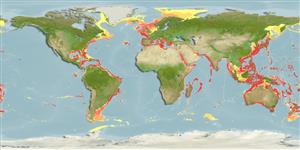Scyphozoa |
Coronatae |
Nausithoidae
Environment: milieu / climate zone / depth range / distribution range
Ecology
Pelagic; depth range 0 - 1000 m (Ref. 116114). Tropical; 85°N - 53°S, 180°W - 180°E (Ref. 121705)
Circumglobal.
Length at first maturity / Size / Weight / Age
Maturity: Lm ? range ? - ? cm Max length : 1.5 cm WD male/unsexed; (Ref. 2992)
0.9 to 1.5 wide, discodial, central disk thick, without radiating furrows, finely punctured; gastral filaments not grouped in clusters; large gonads.
Offshore (Ref. 813). Found in deep waters (Ref. 116114). Abundant in warm waters (Ref. 101746). Feeds on zooplankton (Ref. 101745).
Life cycle and mating behavior
Maturity | Reproduction | Spawning | Eggs | Fecundity | Larvae
Members of the class Scyphozoa are gonochoric. Life cycle: Egg is laid by the adult medusa which later develops into a free-living planula, then to a scyphistoma to a strobila, and lastly to a free-living young medusa.
Migotto, A.E., A.C. Marques, A.C. Morandini and F.L. da Silveira 2002 Checklist of the cnidaria medusozoa of Brazil. Biota Neotropica 2(1):1-31. (Ref. 813)
IUCN Red List Status
(Ref. 130435: Version 2025-1)
CITES status (Ref. 108899)
Not Evaluated
Not Evaluated
Threat to humans
Human uses
| FishSource |
Tools
More information
Population dynamicsGrowth
Max. ages / sizes
Length-weight rel.
Length-length rel.
Length-frequencies
Mass conversion
Abundance
Life cycleReproductionMaturityFecunditySpawningEggsEgg developmentLarvae PhysiologyOxygen consumption
Human RelatedStamps, coins, misc.
Internet sources
Estimates based on models
Fishing Vulnerability
Low vulnerability (10 of 100).
Price category
Unknown.
